Strategic Analysis of Tesco: Evaluating Internal & External Factors
VerifiedAdded on 2023/06/07
|14
|5035
|85
Report
AI Summary
This report provides a comprehensive analysis of Tesco's business strategy, encompassing both internal and external factors that influence its strategic decision-making. It includes a PESTLE analysis, SWOT analysis, and an evaluation of Tesco's resources and capabilities. The competitive environment is examined using Porter's Five Forces model, and the report identifies and justifies Tesco's existing and potential competitive advantages. Furthermore, it evaluates different strategic directions available to Tesco, recommending the most appropriate growth platforms and strategies. The report also suggests ways to monitor the chosen strategies to ensure success, ultimately providing a strategic management plan for Tesco. Desklib offers a variety of resources, including solved assignments and past papers, for students seeking academic assistance.
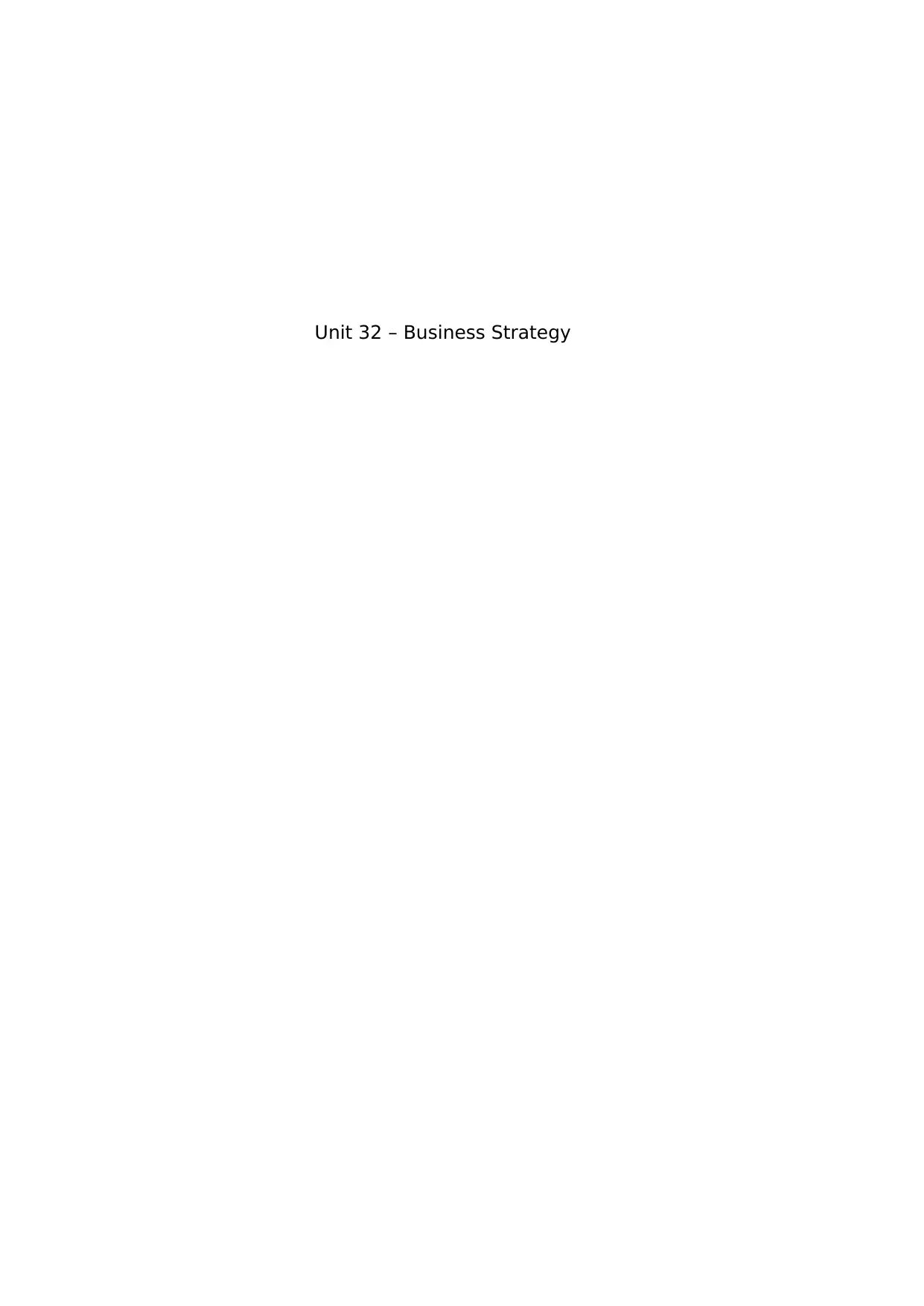
Unit 32 – Business Strategy
Paraphrase This Document
Need a fresh take? Get an instant paraphrase of this document with our AI Paraphraser
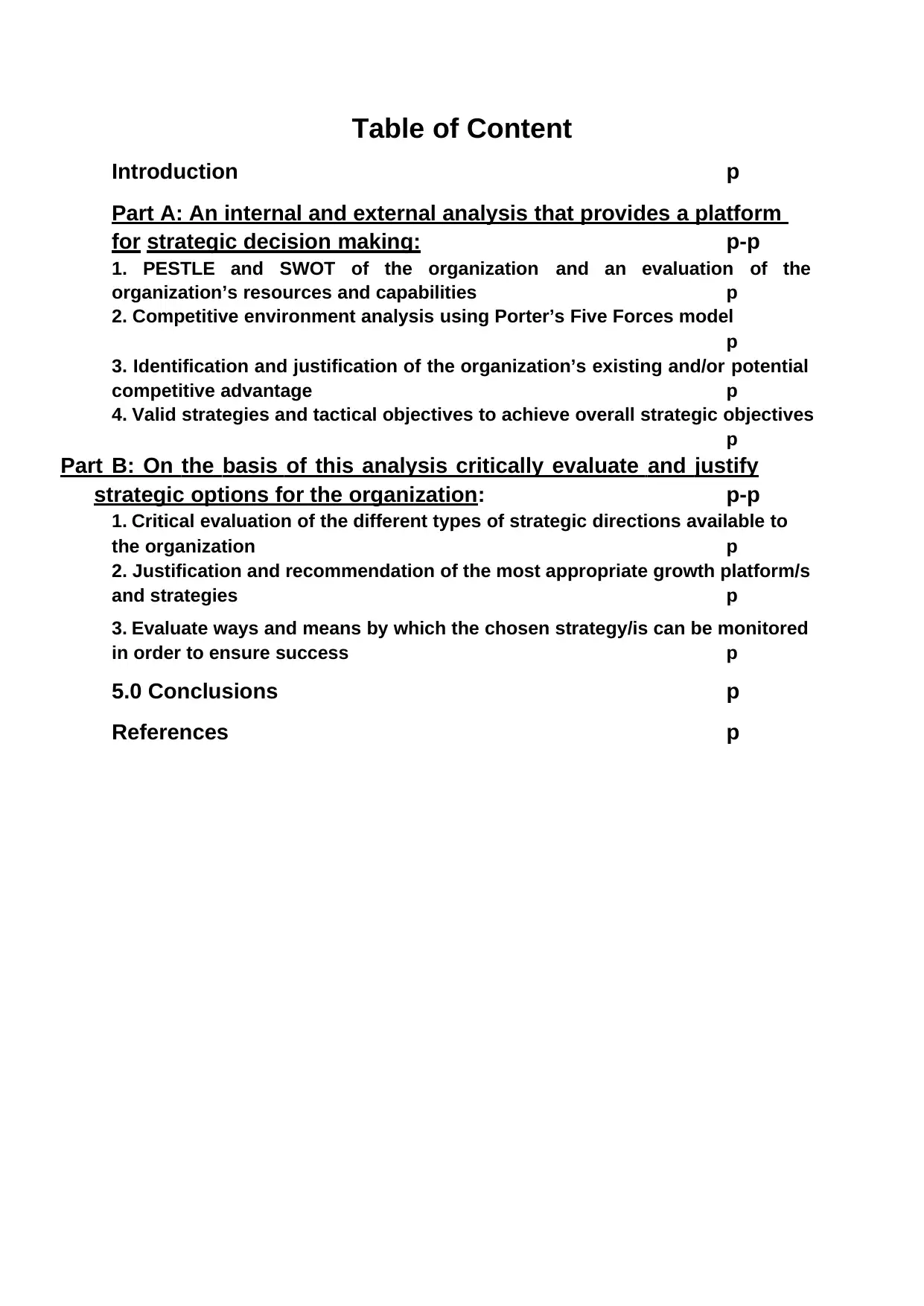
Table of Content
Introduction p
Part A: An internal and external analysis that provides a platform
for strategic decision making: p-p
1. PESTLE and SWOT of the organization and an evaluation of the
organization’s resources and capabilities p
2. Competitive environment analysis using Porter’s Five Forces model
p
3. Identification and justification of the organization’s existing and/or potential
competitive advantage p
4. Valid strategies and tactical objectives to achieve overall strategic objectives
p
Part B: On the basis of this analysis critically evaluate and justify
strategic options for the organization: p-p
1. Critical evaluation of the different types of strategic directions available to
the organization p
2. Justification and recommendation of the most appropriate growth platform/s
and strategies p
3. Evaluate ways and means by which the chosen strategy/is can be monitored
in order to ensure success p
5.0 Conclusions p
References p
Introduction p
Part A: An internal and external analysis that provides a platform
for strategic decision making: p-p
1. PESTLE and SWOT of the organization and an evaluation of the
organization’s resources and capabilities p
2. Competitive environment analysis using Porter’s Five Forces model
p
3. Identification and justification of the organization’s existing and/or potential
competitive advantage p
4. Valid strategies and tactical objectives to achieve overall strategic objectives
p
Part B: On the basis of this analysis critically evaluate and justify
strategic options for the organization: p-p
1. Critical evaluation of the different types of strategic directions available to
the organization p
2. Justification and recommendation of the most appropriate growth platform/s
and strategies p
3. Evaluate ways and means by which the chosen strategy/is can be monitored
in order to ensure success p
5.0 Conclusions p
References p
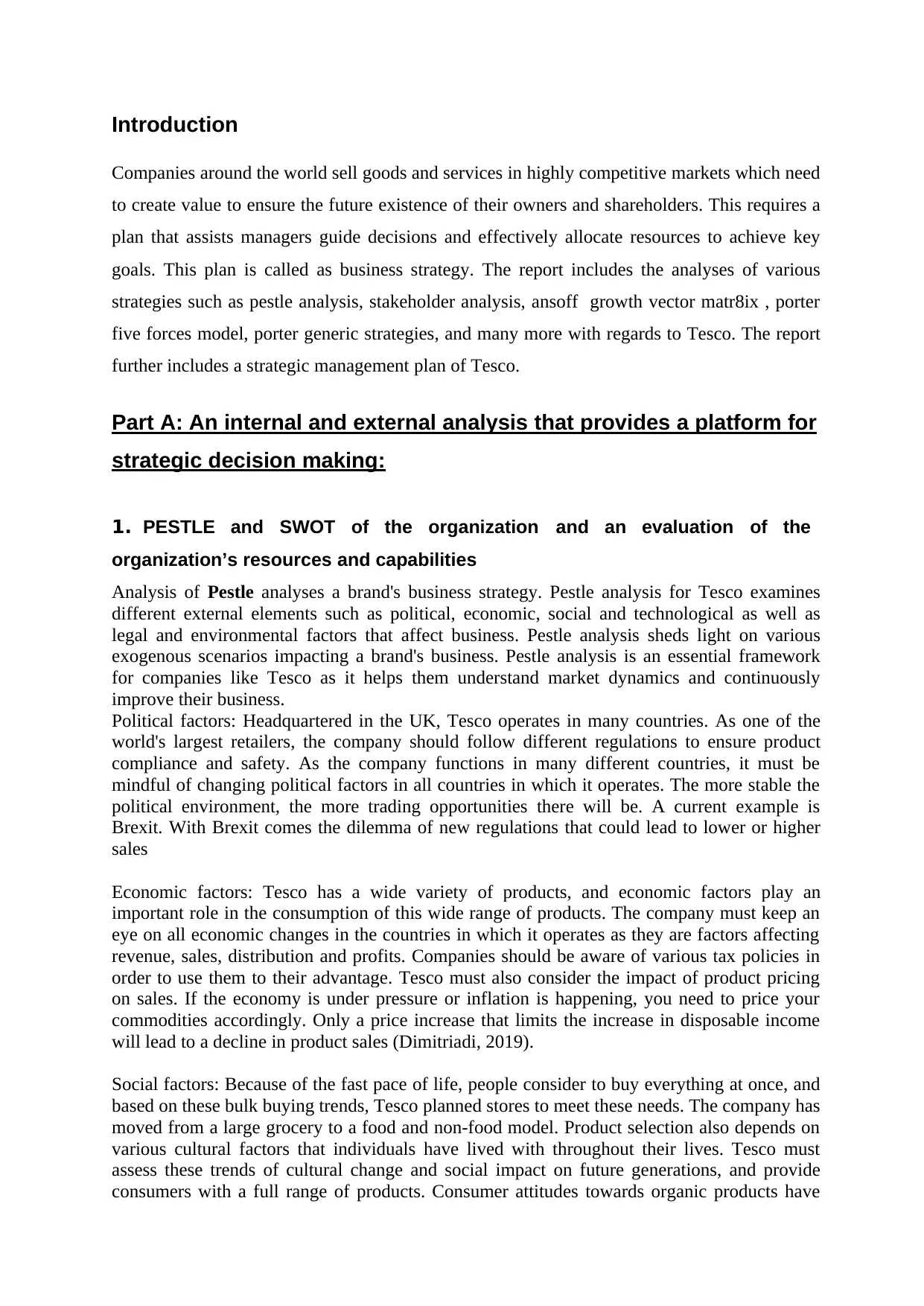
Introduction
Companies around the world sell goods and services in highly competitive markets which need
to create value to ensure the future existence of their owners and shareholders. This requires a
plan that assists managers guide decisions and effectively allocate resources to achieve key
goals. This plan is called as business strategy. The report includes the analyses of various
strategies such as pestle analysis, stakeholder analysis, ansoff growth vector matr8ix , porter
five forces model, porter generic strategies, and many more with regards to Tesco. The report
further includes a strategic management plan of Tesco.
Part A: An internal and external analysis that provides a platform for
strategic decision making:
1. PESTLE and SWOT of the organization and an evaluation of the
organization’s resources and capabilities
Analysis of Pestle analyses a brand's business strategy. Pestle analysis for Tesco examines
different external elements such as political, economic, social and technological as well as
legal and environmental factors that affect business. Pestle analysis sheds light on various
exogenous scenarios impacting a brand's business. Pestle analysis is an essential framework
for companies like Tesco as it helps them understand market dynamics and continuously
improve their business.
Political factors: Headquartered in the UK, Tesco operates in many countries. As one of the
world's largest retailers, the company should follow different regulations to ensure product
compliance and safety. As the company functions in many different countries, it must be
mindful of changing political factors in all countries in which it operates. The more stable the
political environment, the more trading opportunities there will be. A current example is
Brexit. With Brexit comes the dilemma of new regulations that could lead to lower or higher
sales
Economic factors: Tesco has a wide variety of products, and economic factors play an
important role in the consumption of this wide range of products. The company must keep an
eye on all economic changes in the countries in which it operates as they are factors affecting
revenue, sales, distribution and profits. Companies should be aware of various tax policies in
order to use them to their advantage. Tesco must also consider the impact of product pricing
on sales. If the economy is under pressure or inflation is happening, you need to price your
commodities accordingly. Only a price increase that limits the increase in disposable income
will lead to a decline in product sales (Dimitriadi, 2019).
Social factors: Because of the fast pace of life, people consider to buy everything at once, and
based on these bulk buying trends, Tesco planned stores to meet these needs. The company has
moved from a large grocery to a food and non-food model. Product selection also depends on
various cultural factors that individuals have lived with throughout their lives. Tesco must
assess these trends of cultural change and social impact on future generations, and provide
consumers with a full range of products. Consumer attitudes towards organic products have
Companies around the world sell goods and services in highly competitive markets which need
to create value to ensure the future existence of their owners and shareholders. This requires a
plan that assists managers guide decisions and effectively allocate resources to achieve key
goals. This plan is called as business strategy. The report includes the analyses of various
strategies such as pestle analysis, stakeholder analysis, ansoff growth vector matr8ix , porter
five forces model, porter generic strategies, and many more with regards to Tesco. The report
further includes a strategic management plan of Tesco.
Part A: An internal and external analysis that provides a platform for
strategic decision making:
1. PESTLE and SWOT of the organization and an evaluation of the
organization’s resources and capabilities
Analysis of Pestle analyses a brand's business strategy. Pestle analysis for Tesco examines
different external elements such as political, economic, social and technological as well as
legal and environmental factors that affect business. Pestle analysis sheds light on various
exogenous scenarios impacting a brand's business. Pestle analysis is an essential framework
for companies like Tesco as it helps them understand market dynamics and continuously
improve their business.
Political factors: Headquartered in the UK, Tesco operates in many countries. As one of the
world's largest retailers, the company should follow different regulations to ensure product
compliance and safety. As the company functions in many different countries, it must be
mindful of changing political factors in all countries in which it operates. The more stable the
political environment, the more trading opportunities there will be. A current example is
Brexit. With Brexit comes the dilemma of new regulations that could lead to lower or higher
sales
Economic factors: Tesco has a wide variety of products, and economic factors play an
important role in the consumption of this wide range of products. The company must keep an
eye on all economic changes in the countries in which it operates as they are factors affecting
revenue, sales, distribution and profits. Companies should be aware of various tax policies in
order to use them to their advantage. Tesco must also consider the impact of product pricing
on sales. If the economy is under pressure or inflation is happening, you need to price your
commodities accordingly. Only a price increase that limits the increase in disposable income
will lead to a decline in product sales (Dimitriadi, 2019).
Social factors: Because of the fast pace of life, people consider to buy everything at once, and
based on these bulk buying trends, Tesco planned stores to meet these needs. The company has
moved from a large grocery to a food and non-food model. Product selection also depends on
various cultural factors that individuals have lived with throughout their lives. Tesco must
assess these trends of cultural change and social impact on future generations, and provide
consumers with a full range of products. Consumer attitudes towards organic products have
⊘ This is a preview!⊘
Do you want full access?
Subscribe today to unlock all pages.

Trusted by 1+ million students worldwide
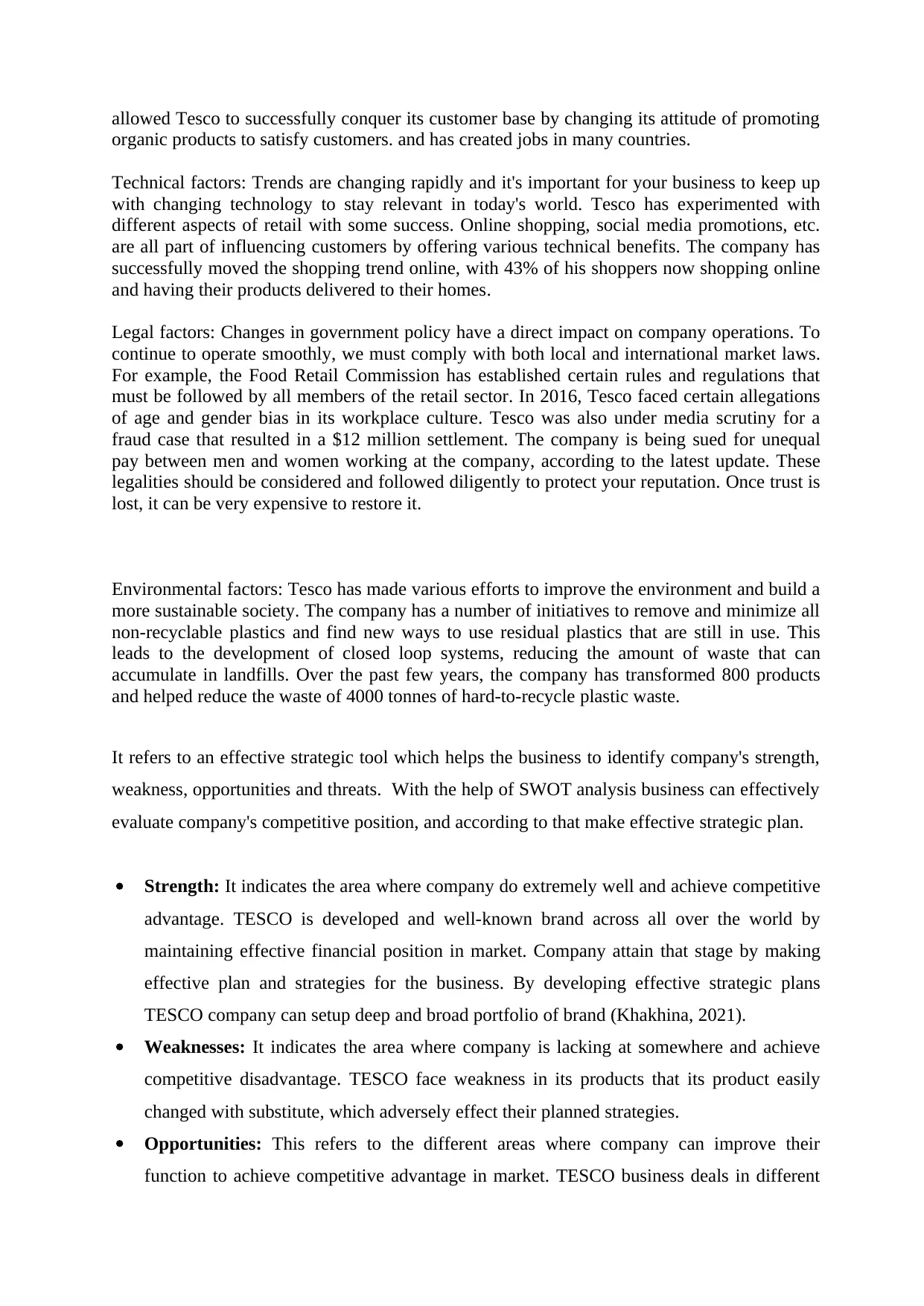
allowed Tesco to successfully conquer its customer base by changing its attitude of promoting
organic products to satisfy customers. and has created jobs in many countries.
Technical factors: Trends are changing rapidly and it's important for your business to keep up
with changing technology to stay relevant in today's world. Tesco has experimented with
different aspects of retail with some success. Online shopping, social media promotions, etc.
are all part of influencing customers by offering various technical benefits. The company has
successfully moved the shopping trend online, with 43% of his shoppers now shopping online
and having their products delivered to their homes.
Legal factors: Changes in government policy have a direct impact on company operations. To
continue to operate smoothly, we must comply with both local and international market laws.
For example, the Food Retail Commission has established certain rules and regulations that
must be followed by all members of the retail sector. In 2016, Tesco faced certain allegations
of age and gender bias in its workplace culture. Tesco was also under media scrutiny for a
fraud case that resulted in a $12 million settlement. The company is being sued for unequal
pay between men and women working at the company, according to the latest update. These
legalities should be considered and followed diligently to protect your reputation. Once trust is
lost, it can be very expensive to restore it.
Environmental factors: Tesco has made various efforts to improve the environment and build a
more sustainable society. The company has a number of initiatives to remove and minimize all
non-recyclable plastics and find new ways to use residual plastics that are still in use. This
leads to the development of closed loop systems, reducing the amount of waste that can
accumulate in landfills. Over the past few years, the company has transformed 800 products
and helped reduce the waste of 4000 tonnes of hard-to-recycle plastic waste.
It refers to an effective strategic tool which helps the business to identify company's strength,
weakness, opportunities and threats. With the help of SWOT analysis business can effectively
evaluate company's competitive position, and according to that make effective strategic plan.
Strength: It indicates the area where company do extremely well and achieve competitive
advantage. TESCO is developed and well-known brand across all over the world by
maintaining effective financial position in market. Company attain that stage by making
effective plan and strategies for the business. By developing effective strategic plans
TESCO company can setup deep and broad portfolio of brand (Khakhina, 2021).
Weaknesses: It indicates the area where company is lacking at somewhere and achieve
competitive disadvantage. TESCO face weakness in its products that its product easily
changed with substitute, which adversely effect their planned strategies.
Opportunities: This refers to the different areas where company can improve their
function to achieve competitive advantage in market. TESCO business deals in different
organic products to satisfy customers. and has created jobs in many countries.
Technical factors: Trends are changing rapidly and it's important for your business to keep up
with changing technology to stay relevant in today's world. Tesco has experimented with
different aspects of retail with some success. Online shopping, social media promotions, etc.
are all part of influencing customers by offering various technical benefits. The company has
successfully moved the shopping trend online, with 43% of his shoppers now shopping online
and having their products delivered to their homes.
Legal factors: Changes in government policy have a direct impact on company operations. To
continue to operate smoothly, we must comply with both local and international market laws.
For example, the Food Retail Commission has established certain rules and regulations that
must be followed by all members of the retail sector. In 2016, Tesco faced certain allegations
of age and gender bias in its workplace culture. Tesco was also under media scrutiny for a
fraud case that resulted in a $12 million settlement. The company is being sued for unequal
pay between men and women working at the company, according to the latest update. These
legalities should be considered and followed diligently to protect your reputation. Once trust is
lost, it can be very expensive to restore it.
Environmental factors: Tesco has made various efforts to improve the environment and build a
more sustainable society. The company has a number of initiatives to remove and minimize all
non-recyclable plastics and find new ways to use residual plastics that are still in use. This
leads to the development of closed loop systems, reducing the amount of waste that can
accumulate in landfills. Over the past few years, the company has transformed 800 products
and helped reduce the waste of 4000 tonnes of hard-to-recycle plastic waste.
It refers to an effective strategic tool which helps the business to identify company's strength,
weakness, opportunities and threats. With the help of SWOT analysis business can effectively
evaluate company's competitive position, and according to that make effective strategic plan.
Strength: It indicates the area where company do extremely well and achieve competitive
advantage. TESCO is developed and well-known brand across all over the world by
maintaining effective financial position in market. Company attain that stage by making
effective plan and strategies for the business. By developing effective strategic plans
TESCO company can setup deep and broad portfolio of brand (Khakhina, 2021).
Weaknesses: It indicates the area where company is lacking at somewhere and achieve
competitive disadvantage. TESCO face weakness in its products that its product easily
changed with substitute, which adversely effect their planned strategies.
Opportunities: This refers to the different areas where company can improve their
function to achieve competitive advantage in market. TESCO business deals in different
Paraphrase This Document
Need a fresh take? Get an instant paraphrase of this document with our AI Paraphraser
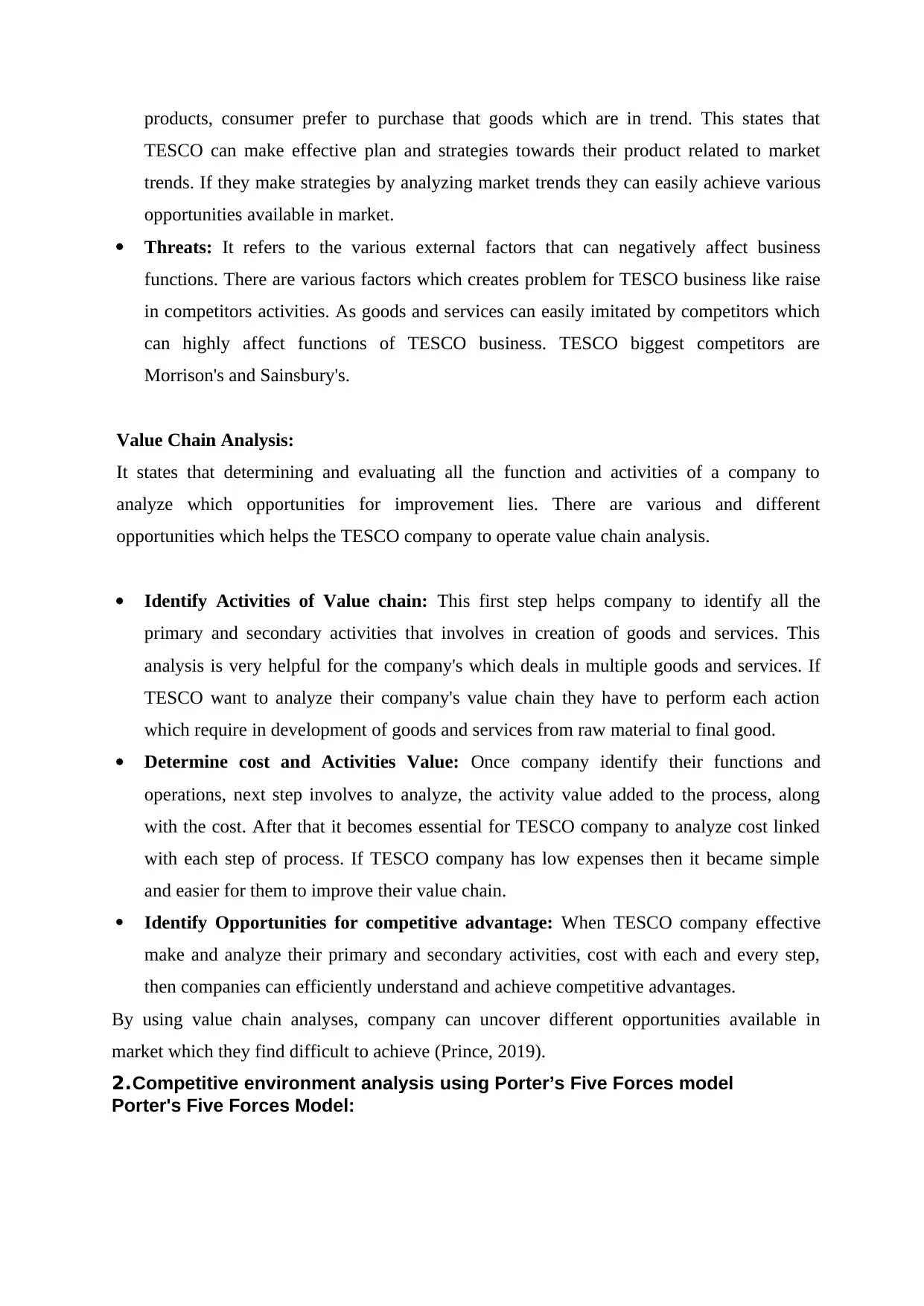
products, consumer prefer to purchase that goods which are in trend. This states that
TESCO can make effective plan and strategies towards their product related to market
trends. If they make strategies by analyzing market trends they can easily achieve various
opportunities available in market.
Threats: It refers to the various external factors that can negatively affect business
functions. There are various factors which creates problem for TESCO business like raise
in competitors activities. As goods and services can easily imitated by competitors which
can highly affect functions of TESCO business. TESCO biggest competitors are
Morrison's and Sainsbury's.
Value Chain Analysis:
It states that determining and evaluating all the function and activities of a company to
analyze which opportunities for improvement lies. There are various and different
opportunities which helps the TESCO company to operate value chain analysis.
Identify Activities of Value chain: This first step helps company to identify all the
primary and secondary activities that involves in creation of goods and services. This
analysis is very helpful for the company's which deals in multiple goods and services. If
TESCO want to analyze their company's value chain they have to perform each action
which require in development of goods and services from raw material to final good.
Determine cost and Activities Value: Once company identify their functions and
operations, next step involves to analyze, the activity value added to the process, along
with the cost. After that it becomes essential for TESCO company to analyze cost linked
with each step of process. If TESCO company has low expenses then it became simple
and easier for them to improve their value chain.
Identify Opportunities for competitive advantage: When TESCO company effective
make and analyze their primary and secondary activities, cost with each and every step,
then companies can efficiently understand and achieve competitive advantages.
By using value chain analyses, company can uncover different opportunities available in
market which they find difficult to achieve (Prince, 2019).
2.Competitive environment analysis using Porter’s Five Forces model
Porter's Five Forces Model:
TESCO can make effective plan and strategies towards their product related to market
trends. If they make strategies by analyzing market trends they can easily achieve various
opportunities available in market.
Threats: It refers to the various external factors that can negatively affect business
functions. There are various factors which creates problem for TESCO business like raise
in competitors activities. As goods and services can easily imitated by competitors which
can highly affect functions of TESCO business. TESCO biggest competitors are
Morrison's and Sainsbury's.
Value Chain Analysis:
It states that determining and evaluating all the function and activities of a company to
analyze which opportunities for improvement lies. There are various and different
opportunities which helps the TESCO company to operate value chain analysis.
Identify Activities of Value chain: This first step helps company to identify all the
primary and secondary activities that involves in creation of goods and services. This
analysis is very helpful for the company's which deals in multiple goods and services. If
TESCO want to analyze their company's value chain they have to perform each action
which require in development of goods and services from raw material to final good.
Determine cost and Activities Value: Once company identify their functions and
operations, next step involves to analyze, the activity value added to the process, along
with the cost. After that it becomes essential for TESCO company to analyze cost linked
with each step of process. If TESCO company has low expenses then it became simple
and easier for them to improve their value chain.
Identify Opportunities for competitive advantage: When TESCO company effective
make and analyze their primary and secondary activities, cost with each and every step,
then companies can efficiently understand and achieve competitive advantages.
By using value chain analyses, company can uncover different opportunities available in
market which they find difficult to achieve (Prince, 2019).
2.Competitive environment analysis using Porter’s Five Forces model
Porter's Five Forces Model:
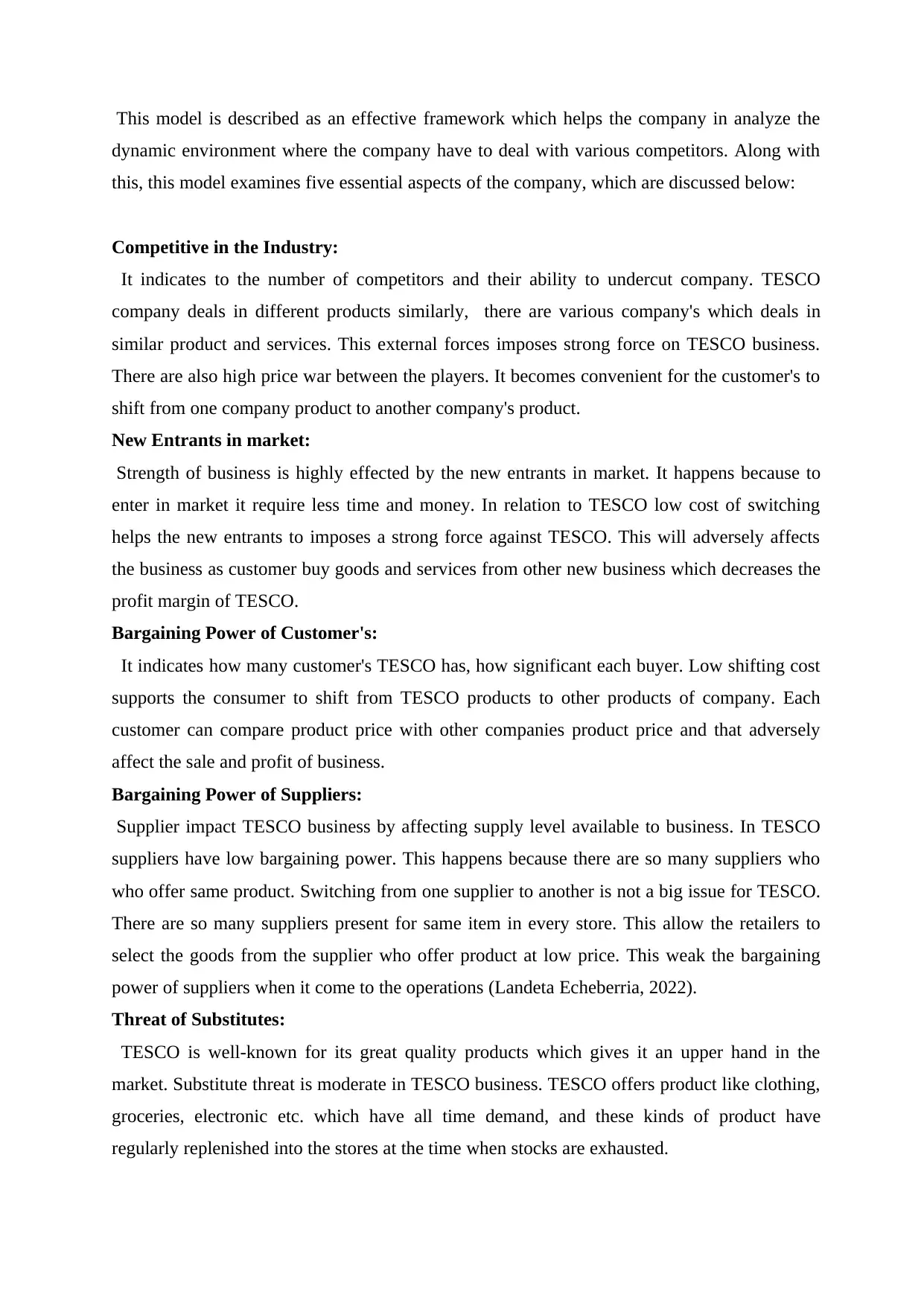
This model is described as an effective framework which helps the company in analyze the
dynamic environment where the company have to deal with various competitors. Along with
this, this model examines five essential aspects of the company, which are discussed below:
Competitive in the Industry:
It indicates to the number of competitors and their ability to undercut company. TESCO
company deals in different products similarly, there are various company's which deals in
similar product and services. This external forces imposes strong force on TESCO business.
There are also high price war between the players. It becomes convenient for the customer's to
shift from one company product to another company's product.
New Entrants in market:
Strength of business is highly effected by the new entrants in market. It happens because to
enter in market it require less time and money. In relation to TESCO low cost of switching
helps the new entrants to imposes a strong force against TESCO. This will adversely affects
the business as customer buy goods and services from other new business which decreases the
profit margin of TESCO.
Bargaining Power of Customer's:
It indicates how many customer's TESCO has, how significant each buyer. Low shifting cost
supports the consumer to shift from TESCO products to other products of company. Each
customer can compare product price with other companies product price and that adversely
affect the sale and profit of business.
Bargaining Power of Suppliers:
Supplier impact TESCO business by affecting supply level available to business. In TESCO
suppliers have low bargaining power. This happens because there are so many suppliers who
who offer same product. Switching from one supplier to another is not a big issue for TESCO.
There are so many suppliers present for same item in every store. This allow the retailers to
select the goods from the supplier who offer product at low price. This weak the bargaining
power of suppliers when it come to the operations (Landeta Echeberria, 2022).
Threat of Substitutes:
TESCO is well-known for its great quality products which gives it an upper hand in the
market. Substitute threat is moderate in TESCO business. TESCO offers product like clothing,
groceries, electronic etc. which have all time demand, and these kinds of product have
regularly replenished into the stores at the time when stocks are exhausted.
dynamic environment where the company have to deal with various competitors. Along with
this, this model examines five essential aspects of the company, which are discussed below:
Competitive in the Industry:
It indicates to the number of competitors and their ability to undercut company. TESCO
company deals in different products similarly, there are various company's which deals in
similar product and services. This external forces imposes strong force on TESCO business.
There are also high price war between the players. It becomes convenient for the customer's to
shift from one company product to another company's product.
New Entrants in market:
Strength of business is highly effected by the new entrants in market. It happens because to
enter in market it require less time and money. In relation to TESCO low cost of switching
helps the new entrants to imposes a strong force against TESCO. This will adversely affects
the business as customer buy goods and services from other new business which decreases the
profit margin of TESCO.
Bargaining Power of Customer's:
It indicates how many customer's TESCO has, how significant each buyer. Low shifting cost
supports the consumer to shift from TESCO products to other products of company. Each
customer can compare product price with other companies product price and that adversely
affect the sale and profit of business.
Bargaining Power of Suppliers:
Supplier impact TESCO business by affecting supply level available to business. In TESCO
suppliers have low bargaining power. This happens because there are so many suppliers who
who offer same product. Switching from one supplier to another is not a big issue for TESCO.
There are so many suppliers present for same item in every store. This allow the retailers to
select the goods from the supplier who offer product at low price. This weak the bargaining
power of suppliers when it come to the operations (Landeta Echeberria, 2022).
Threat of Substitutes:
TESCO is well-known for its great quality products which gives it an upper hand in the
market. Substitute threat is moderate in TESCO business. TESCO offers product like clothing,
groceries, electronic etc. which have all time demand, and these kinds of product have
regularly replenished into the stores at the time when stocks are exhausted.
⊘ This is a preview!⊘
Do you want full access?
Subscribe today to unlock all pages.

Trusted by 1+ million students worldwide
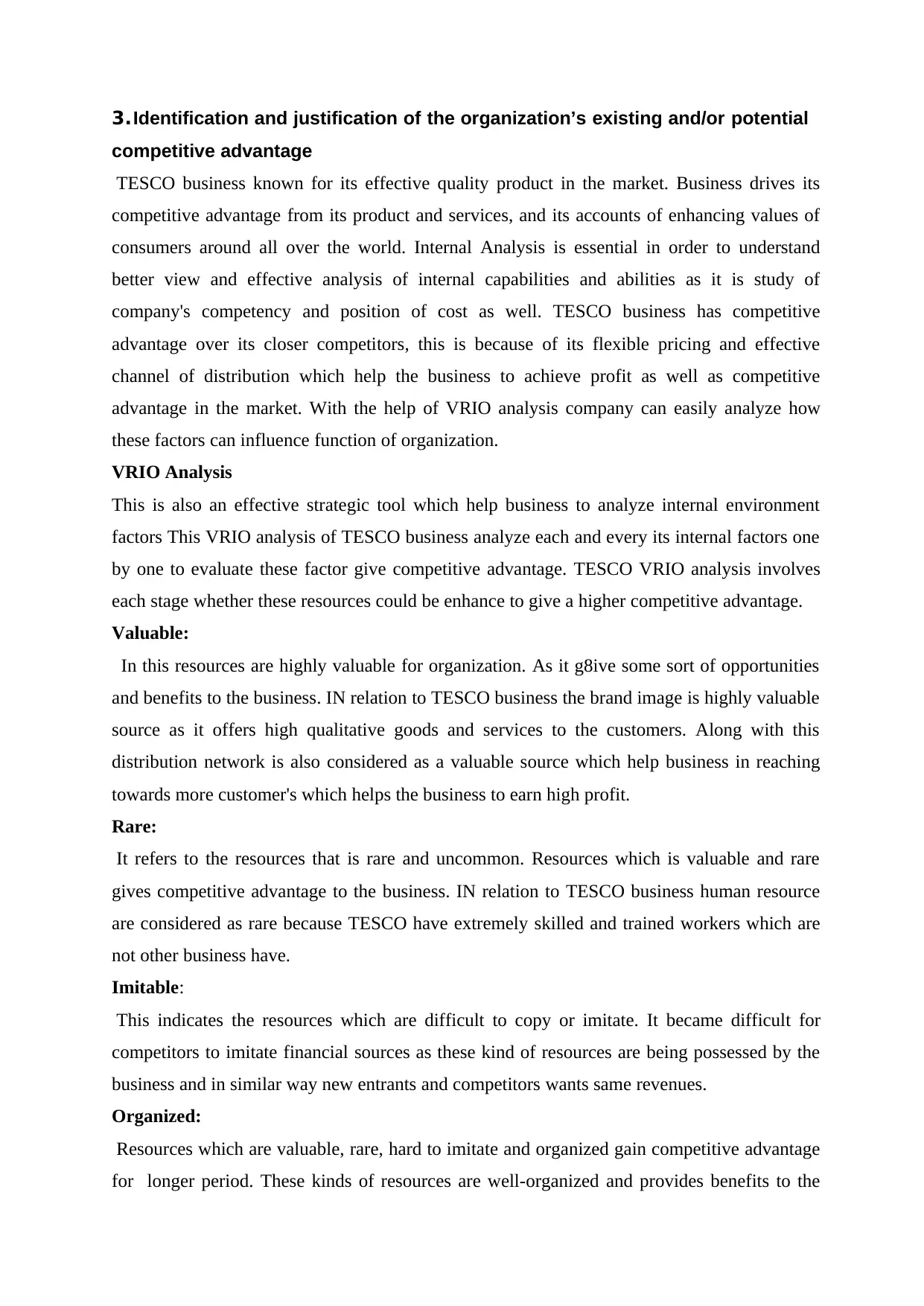
3.Identification and justification of the organization’s existing and/or potential
competitive advantage
TESCO business known for its effective quality product in the market. Business drives its
competitive advantage from its product and services, and its accounts of enhancing values of
consumers around all over the world. Internal Analysis is essential in order to understand
better view and effective analysis of internal capabilities and abilities as it is study of
company's competency and position of cost as well. TESCO business has competitive
advantage over its closer competitors, this is because of its flexible pricing and effective
channel of distribution which help the business to achieve profit as well as competitive
advantage in the market. With the help of VRIO analysis company can easily analyze how
these factors can influence function of organization.
VRIO Analysis
This is also an effective strategic tool which help business to analyze internal environment
factors This VRIO analysis of TESCO business analyze each and every its internal factors one
by one to evaluate these factor give competitive advantage. TESCO VRIO analysis involves
each stage whether these resources could be enhance to give a higher competitive advantage.
Valuable:
In this resources are highly valuable for organization. As it g8ive some sort of opportunities
and benefits to the business. IN relation to TESCO business the brand image is highly valuable
source as it offers high qualitative goods and services to the customers. Along with this
distribution network is also considered as a valuable source which help business in reaching
towards more customer's which helps the business to earn high profit.
Rare:
It refers to the resources that is rare and uncommon. Resources which is valuable and rare
gives competitive advantage to the business. IN relation to TESCO business human resource
are considered as rare because TESCO have extremely skilled and trained workers which are
not other business have.
Imitable:
This indicates the resources which are difficult to copy or imitate. It became difficult for
competitors to imitate financial sources as these kind of resources are being possessed by the
business and in similar way new entrants and competitors wants same revenues.
Organized:
Resources which are valuable, rare, hard to imitate and organized gain competitive advantage
for longer period. These kinds of resources are well-organized and provides benefits to the
competitive advantage
TESCO business known for its effective quality product in the market. Business drives its
competitive advantage from its product and services, and its accounts of enhancing values of
consumers around all over the world. Internal Analysis is essential in order to understand
better view and effective analysis of internal capabilities and abilities as it is study of
company's competency and position of cost as well. TESCO business has competitive
advantage over its closer competitors, this is because of its flexible pricing and effective
channel of distribution which help the business to achieve profit as well as competitive
advantage in the market. With the help of VRIO analysis company can easily analyze how
these factors can influence function of organization.
VRIO Analysis
This is also an effective strategic tool which help business to analyze internal environment
factors This VRIO analysis of TESCO business analyze each and every its internal factors one
by one to evaluate these factor give competitive advantage. TESCO VRIO analysis involves
each stage whether these resources could be enhance to give a higher competitive advantage.
Valuable:
In this resources are highly valuable for organization. As it g8ive some sort of opportunities
and benefits to the business. IN relation to TESCO business the brand image is highly valuable
source as it offers high qualitative goods and services to the customers. Along with this
distribution network is also considered as a valuable source which help business in reaching
towards more customer's which helps the business to earn high profit.
Rare:
It refers to the resources that is rare and uncommon. Resources which is valuable and rare
gives competitive advantage to the business. IN relation to TESCO business human resource
are considered as rare because TESCO have extremely skilled and trained workers which are
not other business have.
Imitable:
This indicates the resources which are difficult to copy or imitate. It became difficult for
competitors to imitate financial sources as these kind of resources are being possessed by the
business and in similar way new entrants and competitors wants same revenues.
Organized:
Resources which are valuable, rare, hard to imitate and organized gain competitive advantage
for longer period. These kinds of resources are well-organized and provides benefits to the
Paraphrase This Document
Need a fresh take? Get an instant paraphrase of this document with our AI Paraphraser
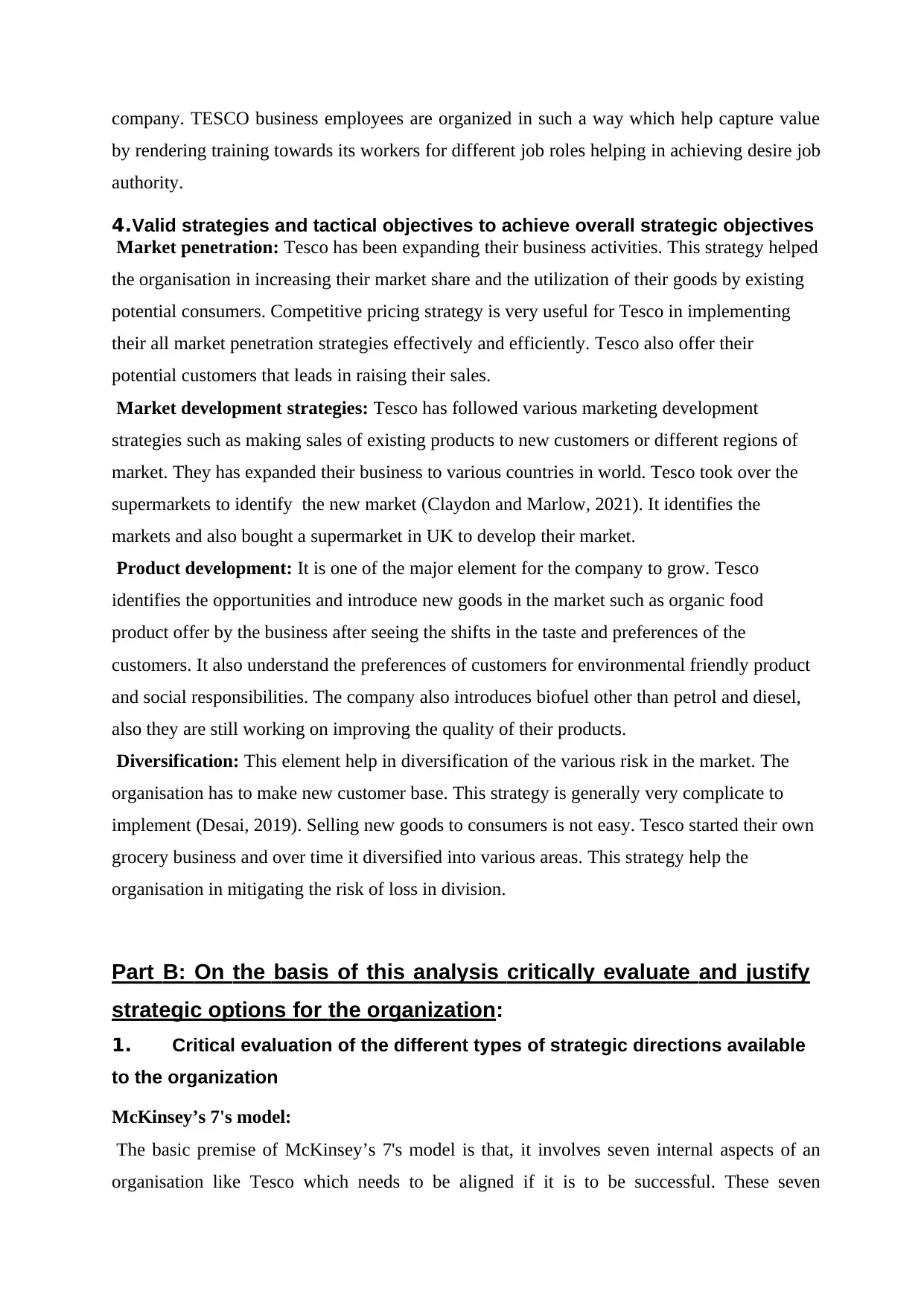
company. TESCO business employees are organized in such a way which help capture value
by rendering training towards its workers for different job roles helping in achieving desire job
authority.
4.Valid strategies and tactical objectives to achieve overall strategic objectives
Market penetration: Tesco has been expanding their business activities. This strategy helped
the organisation in increasing their market share and the utilization of their goods by existing
potential consumers. Competitive pricing strategy is very useful for Tesco in implementing
their all market penetration strategies effectively and efficiently. Tesco also offer their
potential customers that leads in raising their sales.
Market development strategies: Tesco has followed various marketing development
strategies such as making sales of existing products to new customers or different regions of
market. They has expanded their business to various countries in world. Tesco took over the
supermarkets to identify the new market (Claydon and Marlow, 2021). It identifies the
markets and also bought a supermarket in UK to develop their market.
Product development: It is one of the major element for the company to grow. Tesco
identifies the opportunities and introduce new goods in the market such as organic food
product offer by the business after seeing the shifts in the taste and preferences of the
customers. It also understand the preferences of customers for environmental friendly product
and social responsibilities. The company also introduces biofuel other than petrol and diesel,
also they are still working on improving the quality of their products.
Diversification: This element help in diversification of the various risk in the market. The
organisation has to make new customer base. This strategy is generally very complicate to
implement (Desai, 2019). Selling new goods to consumers is not easy. Tesco started their own
grocery business and over time it diversified into various areas. This strategy help the
organisation in mitigating the risk of loss in division.
Part B: On the basis of this analysis critically evaluate and justify
strategic options for the organization:
1. Critical evaluation of the different types of strategic directions available
to the organization
McKinsey’s 7's model:
The basic premise of McKinsey’s 7's model is that, it involves seven internal aspects of an
organisation like Tesco which needs to be aligned if it is to be successful. These seven
by rendering training towards its workers for different job roles helping in achieving desire job
authority.
4.Valid strategies and tactical objectives to achieve overall strategic objectives
Market penetration: Tesco has been expanding their business activities. This strategy helped
the organisation in increasing their market share and the utilization of their goods by existing
potential consumers. Competitive pricing strategy is very useful for Tesco in implementing
their all market penetration strategies effectively and efficiently. Tesco also offer their
potential customers that leads in raising their sales.
Market development strategies: Tesco has followed various marketing development
strategies such as making sales of existing products to new customers or different regions of
market. They has expanded their business to various countries in world. Tesco took over the
supermarkets to identify the new market (Claydon and Marlow, 2021). It identifies the
markets and also bought a supermarket in UK to develop their market.
Product development: It is one of the major element for the company to grow. Tesco
identifies the opportunities and introduce new goods in the market such as organic food
product offer by the business after seeing the shifts in the taste and preferences of the
customers. It also understand the preferences of customers for environmental friendly product
and social responsibilities. The company also introduces biofuel other than petrol and diesel,
also they are still working on improving the quality of their products.
Diversification: This element help in diversification of the various risk in the market. The
organisation has to make new customer base. This strategy is generally very complicate to
implement (Desai, 2019). Selling new goods to consumers is not easy. Tesco started their own
grocery business and over time it diversified into various areas. This strategy help the
organisation in mitigating the risk of loss in division.
Part B: On the basis of this analysis critically evaluate and justify
strategic options for the organization:
1. Critical evaluation of the different types of strategic directions available
to the organization
McKinsey’s 7's model:
The basic premise of McKinsey’s 7's model is that, it involves seven internal aspects of an
organisation like Tesco which needs to be aligned if it is to be successful. These seven
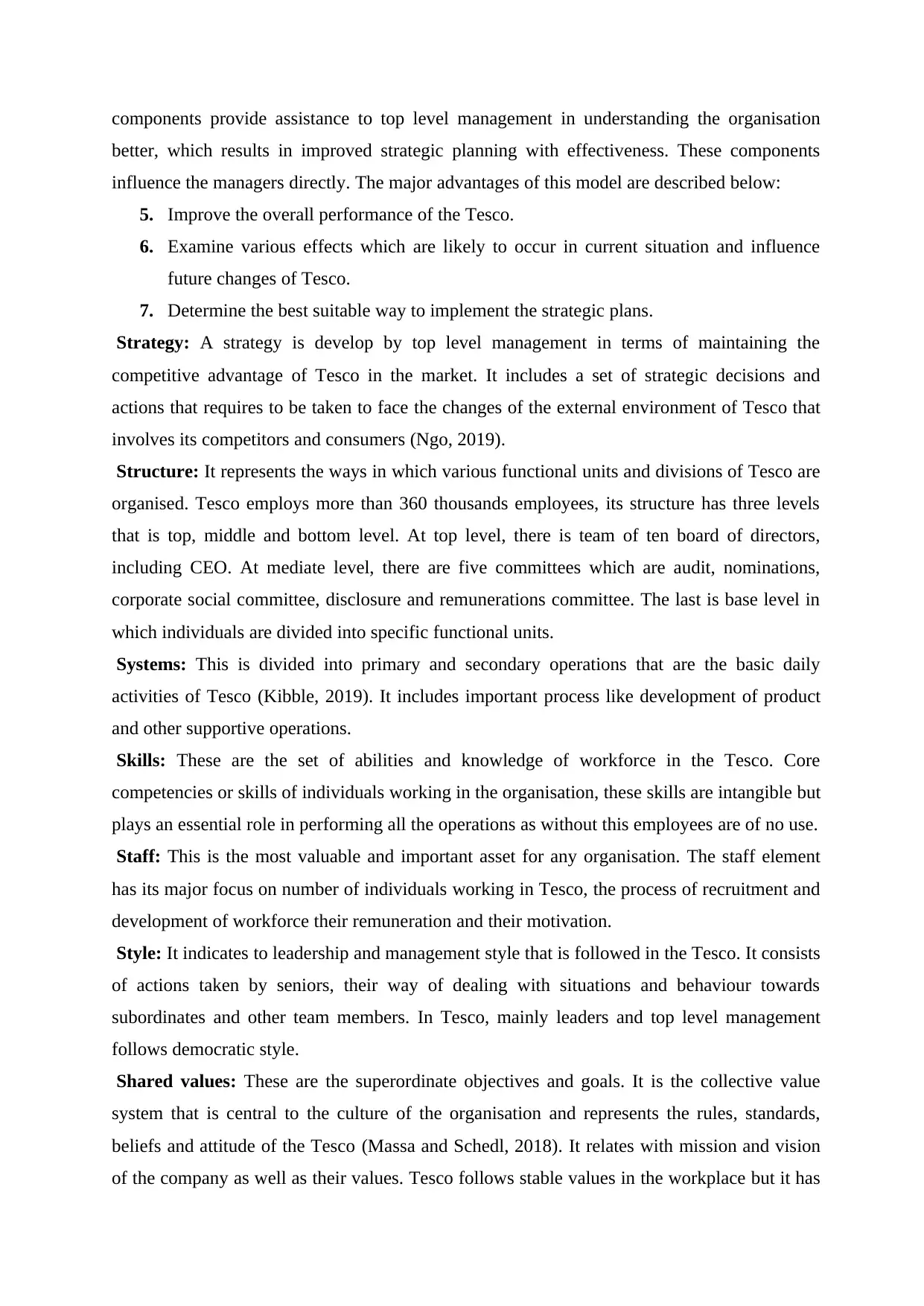
components provide assistance to top level management in understanding the organisation
better, which results in improved strategic planning with effectiveness. These components
influence the managers directly. The major advantages of this model are described below:
5. Improve the overall performance of the Tesco.
6. Examine various effects which are likely to occur in current situation and influence
future changes of Tesco.
7. Determine the best suitable way to implement the strategic plans.
Strategy: A strategy is develop by top level management in terms of maintaining the
competitive advantage of Tesco in the market. It includes a set of strategic decisions and
actions that requires to be taken to face the changes of the external environment of Tesco that
involves its competitors and consumers (Ngo, 2019).
Structure: It represents the ways in which various functional units and divisions of Tesco are
organised. Tesco employs more than 360 thousands employees, its structure has three levels
that is top, middle and bottom level. At top level, there is team of ten board of directors,
including CEO. At mediate level, there are five committees which are audit, nominations,
corporate social committee, disclosure and remunerations committee. The last is base level in
which individuals are divided into specific functional units.
Systems: This is divided into primary and secondary operations that are the basic daily
activities of Tesco (Kibble, 2019). It includes important process like development of product
and other supportive operations.
Skills: These are the set of abilities and knowledge of workforce in the Tesco. Core
competencies or skills of individuals working in the organisation, these skills are intangible but
plays an essential role in performing all the operations as without this employees are of no use.
Staff: This is the most valuable and important asset for any organisation. The staff element
has its major focus on number of individuals working in Tesco, the process of recruitment and
development of workforce their remuneration and their motivation.
Style: It indicates to leadership and management style that is followed in the Tesco. It consists
of actions taken by seniors, their way of dealing with situations and behaviour towards
subordinates and other team members. In Tesco, mainly leaders and top level management
follows democratic style.
Shared values: These are the superordinate objectives and goals. It is the collective value
system that is central to the culture of the organisation and represents the rules, standards,
beliefs and attitude of the Tesco (Massa and Schedl, 2018). It relates with mission and vision
of the company as well as their values. Tesco follows stable values in the workplace but it has
better, which results in improved strategic planning with effectiveness. These components
influence the managers directly. The major advantages of this model are described below:
5. Improve the overall performance of the Tesco.
6. Examine various effects which are likely to occur in current situation and influence
future changes of Tesco.
7. Determine the best suitable way to implement the strategic plans.
Strategy: A strategy is develop by top level management in terms of maintaining the
competitive advantage of Tesco in the market. It includes a set of strategic decisions and
actions that requires to be taken to face the changes of the external environment of Tesco that
involves its competitors and consumers (Ngo, 2019).
Structure: It represents the ways in which various functional units and divisions of Tesco are
organised. Tesco employs more than 360 thousands employees, its structure has three levels
that is top, middle and bottom level. At top level, there is team of ten board of directors,
including CEO. At mediate level, there are five committees which are audit, nominations,
corporate social committee, disclosure and remunerations committee. The last is base level in
which individuals are divided into specific functional units.
Systems: This is divided into primary and secondary operations that are the basic daily
activities of Tesco (Kibble, 2019). It includes important process like development of product
and other supportive operations.
Skills: These are the set of abilities and knowledge of workforce in the Tesco. Core
competencies or skills of individuals working in the organisation, these skills are intangible but
plays an essential role in performing all the operations as without this employees are of no use.
Staff: This is the most valuable and important asset for any organisation. The staff element
has its major focus on number of individuals working in Tesco, the process of recruitment and
development of workforce their remuneration and their motivation.
Style: It indicates to leadership and management style that is followed in the Tesco. It consists
of actions taken by seniors, their way of dealing with situations and behaviour towards
subordinates and other team members. In Tesco, mainly leaders and top level management
follows democratic style.
Shared values: These are the superordinate objectives and goals. It is the collective value
system that is central to the culture of the organisation and represents the rules, standards,
beliefs and attitude of the Tesco (Massa and Schedl, 2018). It relates with mission and vision
of the company as well as their values. Tesco follows stable values in the workplace but it has
⊘ This is a preview!⊘
Do you want full access?
Subscribe today to unlock all pages.

Trusted by 1+ million students worldwide
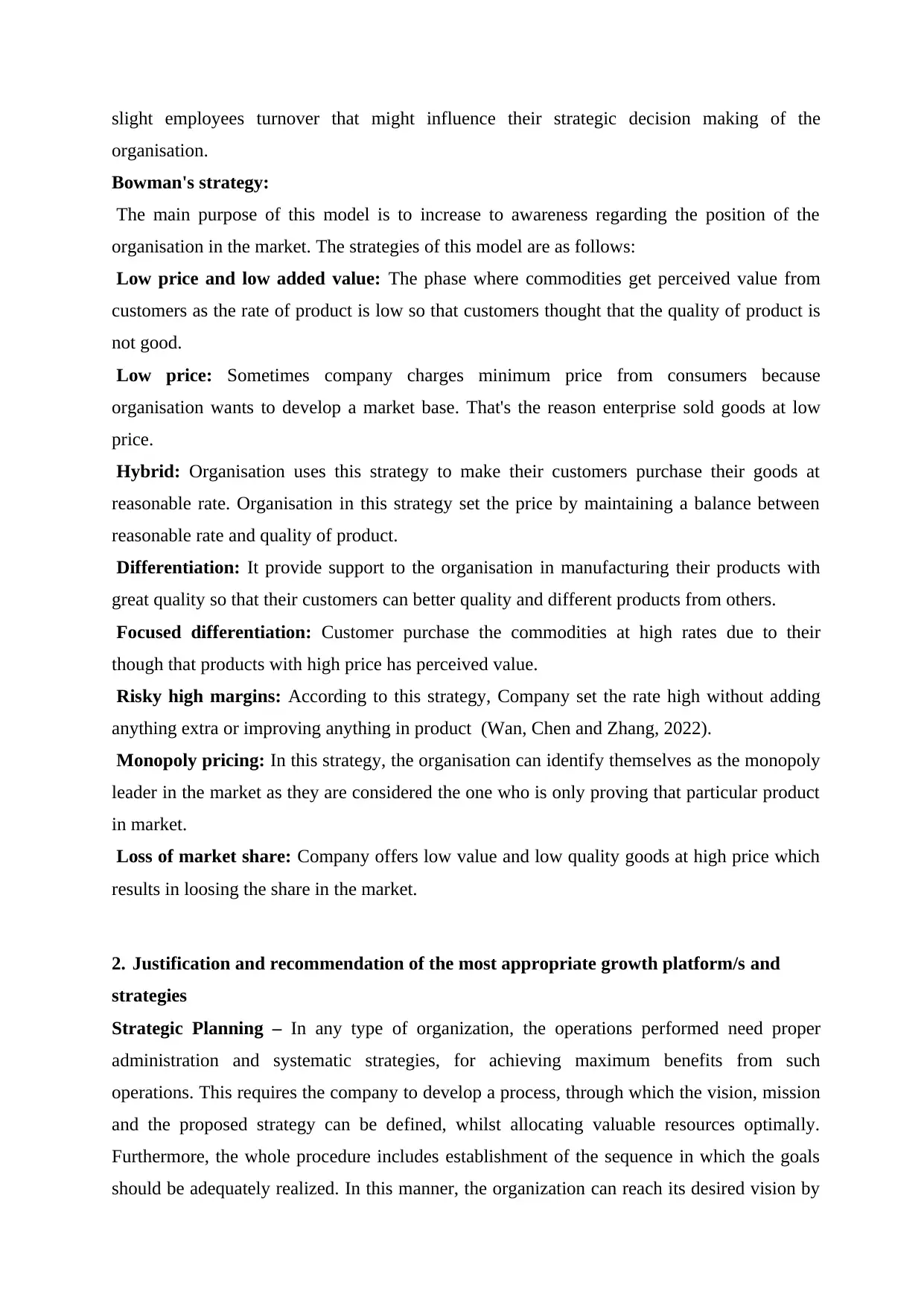
slight employees turnover that might influence their strategic decision making of the
organisation.
Bowman's strategy:
The main purpose of this model is to increase to awareness regarding the position of the
organisation in the market. The strategies of this model are as follows:
Low price and low added value: The phase where commodities get perceived value from
customers as the rate of product is low so that customers thought that the quality of product is
not good.
Low price: Sometimes company charges minimum price from consumers because
organisation wants to develop a market base. That's the reason enterprise sold goods at low
price.
Hybrid: Organisation uses this strategy to make their customers purchase their goods at
reasonable rate. Organisation in this strategy set the price by maintaining a balance between
reasonable rate and quality of product.
Differentiation: It provide support to the organisation in manufacturing their products with
great quality so that their customers can better quality and different products from others.
Focused differentiation: Customer purchase the commodities at high rates due to their
though that products with high price has perceived value.
Risky high margins: According to this strategy, Company set the rate high without adding
anything extra or improving anything in product (Wan, Chen and Zhang, 2022).
Monopoly pricing: In this strategy, the organisation can identify themselves as the monopoly
leader in the market as they are considered the one who is only proving that particular product
in market.
Loss of market share: Company offers low value and low quality goods at high price which
results in loosing the share in the market.
2. Justification and recommendation of the most appropriate growth platform/s and
strategies
Strategic Planning – In any type of organization, the operations performed need proper
administration and systematic strategies, for achieving maximum benefits from such
operations. This requires the company to develop a process, through which the vision, mission
and the proposed strategy can be defined, whilst allocating valuable resources optimally.
Furthermore, the whole procedure includes establishment of the sequence in which the goals
should be adequately realized. In this manner, the organization can reach its desired vision by
organisation.
Bowman's strategy:
The main purpose of this model is to increase to awareness regarding the position of the
organisation in the market. The strategies of this model are as follows:
Low price and low added value: The phase where commodities get perceived value from
customers as the rate of product is low so that customers thought that the quality of product is
not good.
Low price: Sometimes company charges minimum price from consumers because
organisation wants to develop a market base. That's the reason enterprise sold goods at low
price.
Hybrid: Organisation uses this strategy to make their customers purchase their goods at
reasonable rate. Organisation in this strategy set the price by maintaining a balance between
reasonable rate and quality of product.
Differentiation: It provide support to the organisation in manufacturing their products with
great quality so that their customers can better quality and different products from others.
Focused differentiation: Customer purchase the commodities at high rates due to their
though that products with high price has perceived value.
Risky high margins: According to this strategy, Company set the rate high without adding
anything extra or improving anything in product (Wan, Chen and Zhang, 2022).
Monopoly pricing: In this strategy, the organisation can identify themselves as the monopoly
leader in the market as they are considered the one who is only proving that particular product
in market.
Loss of market share: Company offers low value and low quality goods at high price which
results in loosing the share in the market.
2. Justification and recommendation of the most appropriate growth platform/s and
strategies
Strategic Planning – In any type of organization, the operations performed need proper
administration and systematic strategies, for achieving maximum benefits from such
operations. This requires the company to develop a process, through which the vision, mission
and the proposed strategy can be defined, whilst allocating valuable resources optimally.
Furthermore, the whole procedure includes establishment of the sequence in which the goals
should be adequately realized. In this manner, the organization can reach its desired vision by
Paraphrase This Document
Need a fresh take? Get an instant paraphrase of this document with our AI Paraphraser
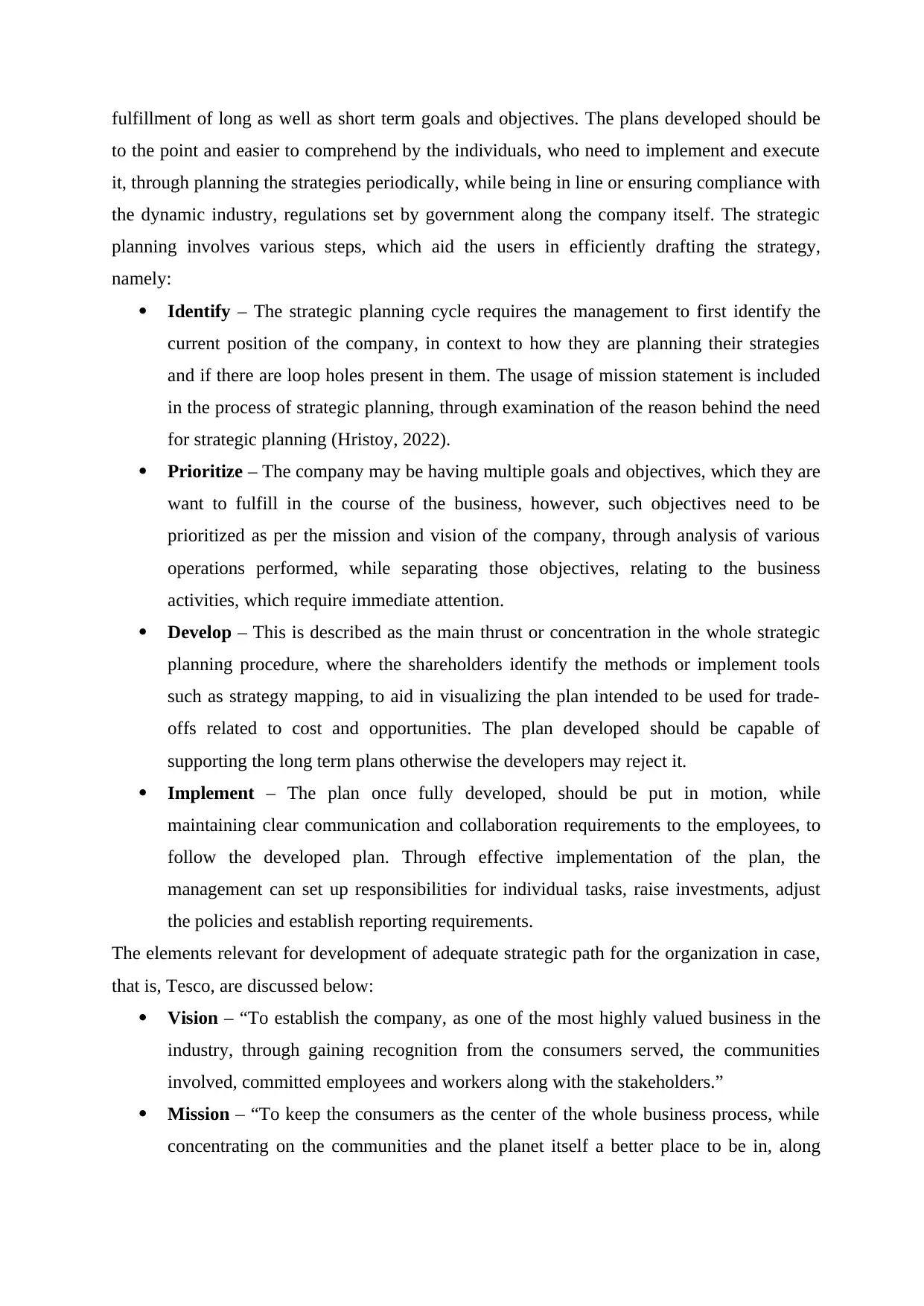
fulfillment of long as well as short term goals and objectives. The plans developed should be
to the point and easier to comprehend by the individuals, who need to implement and execute
it, through planning the strategies periodically, while being in line or ensuring compliance with
the dynamic industry, regulations set by government along the company itself. The strategic
planning involves various steps, which aid the users in efficiently drafting the strategy,
namely:
Identify – The strategic planning cycle requires the management to first identify the
current position of the company, in context to how they are planning their strategies
and if there are loop holes present in them. The usage of mission statement is included
in the process of strategic planning, through examination of the reason behind the need
for strategic planning (Hristoy, 2022).
Prioritize – The company may be having multiple goals and objectives, which they are
want to fulfill in the course of the business, however, such objectives need to be
prioritized as per the mission and vision of the company, through analysis of various
operations performed, while separating those objectives, relating to the business
activities, which require immediate attention.
Develop – This is described as the main thrust or concentration in the whole strategic
planning procedure, where the shareholders identify the methods or implement tools
such as strategy mapping, to aid in visualizing the plan intended to be used for trade-
offs related to cost and opportunities. The plan developed should be capable of
supporting the long term plans otherwise the developers may reject it.
Implement – The plan once fully developed, should be put in motion, while
maintaining clear communication and collaboration requirements to the employees, to
follow the developed plan. Through effective implementation of the plan, the
management can set up responsibilities for individual tasks, raise investments, adjust
the policies and establish reporting requirements.
The elements relevant for development of adequate strategic path for the organization in case,
that is, Tesco, are discussed below:
Vision – “To establish the company, as one of the most highly valued business in the
industry, through gaining recognition from the consumers served, the communities
involved, committed employees and workers along with the stakeholders.”
Mission – “To keep the consumers as the center of the whole business process, while
concentrating on the communities and the planet itself a better place to be in, along
to the point and easier to comprehend by the individuals, who need to implement and execute
it, through planning the strategies periodically, while being in line or ensuring compliance with
the dynamic industry, regulations set by government along the company itself. The strategic
planning involves various steps, which aid the users in efficiently drafting the strategy,
namely:
Identify – The strategic planning cycle requires the management to first identify the
current position of the company, in context to how they are planning their strategies
and if there are loop holes present in them. The usage of mission statement is included
in the process of strategic planning, through examination of the reason behind the need
for strategic planning (Hristoy, 2022).
Prioritize – The company may be having multiple goals and objectives, which they are
want to fulfill in the course of the business, however, such objectives need to be
prioritized as per the mission and vision of the company, through analysis of various
operations performed, while separating those objectives, relating to the business
activities, which require immediate attention.
Develop – This is described as the main thrust or concentration in the whole strategic
planning procedure, where the shareholders identify the methods or implement tools
such as strategy mapping, to aid in visualizing the plan intended to be used for trade-
offs related to cost and opportunities. The plan developed should be capable of
supporting the long term plans otherwise the developers may reject it.
Implement – The plan once fully developed, should be put in motion, while
maintaining clear communication and collaboration requirements to the employees, to
follow the developed plan. Through effective implementation of the plan, the
management can set up responsibilities for individual tasks, raise investments, adjust
the policies and establish reporting requirements.
The elements relevant for development of adequate strategic path for the organization in case,
that is, Tesco, are discussed below:
Vision – “To establish the company, as one of the most highly valued business in the
industry, through gaining recognition from the consumers served, the communities
involved, committed employees and workers along with the stakeholders.”
Mission – “To keep the consumers as the center of the whole business process, while
concentrating on the communities and the planet itself a better place to be in, along
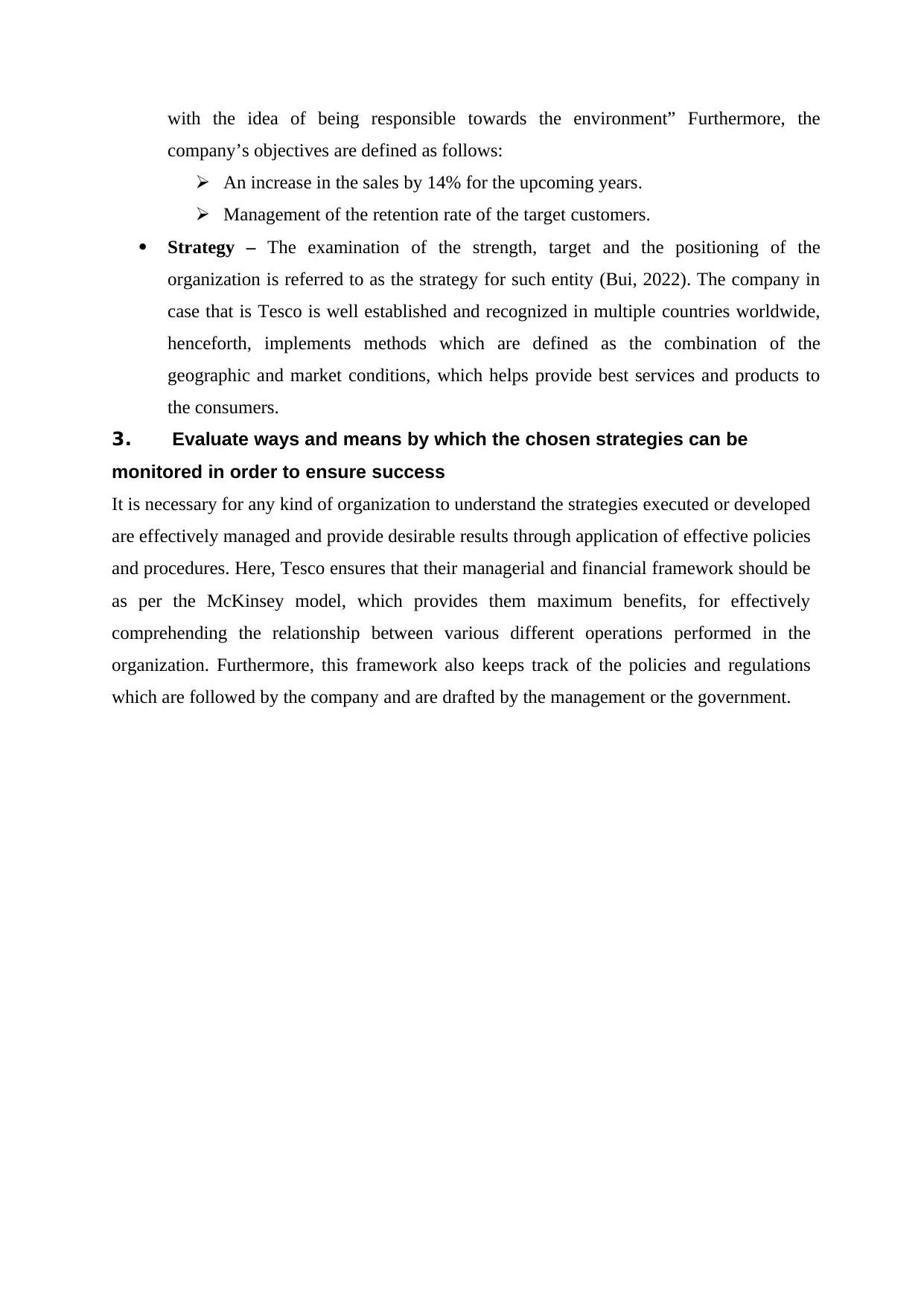
with the idea of being responsible towards the environment” Furthermore, the
company’s objectives are defined as follows:
An increase in the sales by 14% for the upcoming years.
Management of the retention rate of the target customers.
Strategy – The examination of the strength, target and the positioning of the
organization is referred to as the strategy for such entity (Bui, 2022). The company in
case that is Tesco is well established and recognized in multiple countries worldwide,
henceforth, implements methods which are defined as the combination of the
geographic and market conditions, which helps provide best services and products to
the consumers.
3. Evaluate ways and means by which the chosen strategies can be
monitored in order to ensure success
It is necessary for any kind of organization to understand the strategies executed or developed
are effectively managed and provide desirable results through application of effective policies
and procedures. Here, Tesco ensures that their managerial and financial framework should be
as per the McKinsey model, which provides them maximum benefits, for effectively
comprehending the relationship between various different operations performed in the
organization. Furthermore, this framework also keeps track of the policies and regulations
which are followed by the company and are drafted by the management or the government.
company’s objectives are defined as follows:
An increase in the sales by 14% for the upcoming years.
Management of the retention rate of the target customers.
Strategy – The examination of the strength, target and the positioning of the
organization is referred to as the strategy for such entity (Bui, 2022). The company in
case that is Tesco is well established and recognized in multiple countries worldwide,
henceforth, implements methods which are defined as the combination of the
geographic and market conditions, which helps provide best services and products to
the consumers.
3. Evaluate ways and means by which the chosen strategies can be
monitored in order to ensure success
It is necessary for any kind of organization to understand the strategies executed or developed
are effectively managed and provide desirable results through application of effective policies
and procedures. Here, Tesco ensures that their managerial and financial framework should be
as per the McKinsey model, which provides them maximum benefits, for effectively
comprehending the relationship between various different operations performed in the
organization. Furthermore, this framework also keeps track of the policies and regulations
which are followed by the company and are drafted by the management or the government.
⊘ This is a preview!⊘
Do you want full access?
Subscribe today to unlock all pages.

Trusted by 1+ million students worldwide
1 out of 14
Related Documents
Your All-in-One AI-Powered Toolkit for Academic Success.
+13062052269
info@desklib.com
Available 24*7 on WhatsApp / Email
![[object Object]](/_next/static/media/star-bottom.7253800d.svg)
Unlock your academic potential
Copyright © 2020–2025 A2Z Services. All Rights Reserved. Developed and managed by ZUCOL.

